April Showers Bring Nazi Startups
Spring 2025 Azov Lobby Review: 'Fortifying the strategic partnership'
Special Operations Week
During the first week of May, the Special Operations Medical Association (SOMA) held its annual conference in Raleigh, North Carolina, “the largest gathering of Special Operations Forces medical providers in the world.”
At least a few medics from the so-called “depoliticized” Azov Brigade/Corps in the National Guard of Ukraine spoke at the event, including Lt. Daryna Smolnikova, who rubbed shoulders with George Soros’ heir at the World Economic Forum in January. Her boyfriend, the famous Azov officer “Gandalf,” who once said he doesn’t “believe in any holocaust, it’s just a story,” already made it to Davos last year. More recently, Illia “Gandalf” Samoilenko met the right-wing pundit Ben Shapiro during his trip to Ukraine for an interview of Volodymyr Zelensky.
The Azov movement’s 3rd Assault Brigade, a more openly neo-Nazi military unit, also sent a delegation to SOMA 2025, thanks to the New York City-based NGO “Razom for Ukraine,” which has been described as the Ukrainian AIPAC. At least some speakers at this event dedicated their time to sharing “key lessons from Ukraine’s medical response … to adapt TCCC [Tactical Combat Casualty Care] practices for future peer conflicts,” that is, between the United States and China.
Meanwhile, “SOF Week 2025” kicked off in Tampa, Florida, “the premier annual event for the international Special Operations Forces (SOF) community.” Featured speakers included US intelligence chiefs and military commanders, foreign leaders and defense ministers, with keynote speeches by Pete Hegseth, US Secretary of Defense; Gen. Dan Caine, Chairman of the Joint Chiefs of Staff; and Gen. Bryan P. Fenton, Commander of the US Special Operations Command.
“Everything starts and ends with warriors, from training to the battlefield,” said Hegseth. “We are leaving wokeness and weakness behind. No more pronouns, no more climate change obsession, no more emergency vaccine mandates, no more dudes in dresses.” Straight Arrow News reports, “According to Secretary of Defense Pete Hegseth, SOF will shift from a counterterrorism-centric mission to a broader role in great power competition.”
Andriy Smolensky, a severely wounded Ukrainian veteran who has spent many months undergoing treatment in the United States, met General Fenton at SOF Week, which Smolensky attended as the “U.S. Partnership Officer” of a new US-Ukrainian think tank connected to the Azov movement. About a month earlier at Harvard Business School, under the cover of this recently established organization, which is “dedicated to fortifying the strategic partnership between Ukraine and the United States,” some prominent Azovites probably met Fenton’s Vice Commander of the Special Operations Command. These and other stories about the burgeoning “Azov Lobby” have flown under the radar in recent months.
Nazi Tech Movement
“It’s no secret that all top brigades have their own R&D [research and development],” according to Roman Sudolsky, the editor of an online publication “covering Ukrainian defense tech,” but last month, when the 3rd Assault Brigade (AB3), allegedly the largest of its kind, launched its own “startup accelerator” to support testing new military technology on the battlefield, Sudolsky praised this “next level” step taken by the Azov movement, which is currently forming the 3rd Army Corps. A “Global Macro Investor” based in the San Francisco Bay Area also described the founding of “AB3 Tech” as “next level thinking … to get the best tech for the frontlines.”
To hear it from the Azovites, “We combine the expertise of military professionals, engineers, and entrepreneurs to help startups, investors, and defense companies accelerate time-to-market, test products in real combat conditions, and attract funding.” AB3 Tech offers “rapid feedback,” “practical insights,” “brand recognition,” a “competitive edge,” “combat-proven performance data,” “video content of product performance in battlefield conditions,” and official “letters of interest to gain credibility in fundraising.” Their website promises that these neo-Nazis are “trusted by defence industry leaders for real-world validation.”
On May 16-17, the capital of Ukraine hosted “DOU Day,” an annual event which is said to be “one of the largest technical conferences for the Ukrainian IT community.” One of the main speakers was Andriy Biletsky, the leader and founder of the Azov movement, and an infamous neo-Nazi, put in charge of the new 3rd Army Corps. The Azovites called this event their first “IT Dvizh.” As the journalist Leonid Ragozin explains, the Russian word Dvizh is “a slang term widely used by Russian and Ukrainian neo-nazis to designate their [‘NS’ or National Socialist] movement.” Celebrating its 20th anniversary, the Ukrainian IT community “DOU” launched a large fundraiser for the 3rd Assault Brigade, just as AB3 Tech got off the ground. DOU even rolled out a special website for the campaign.
This seasonal edition of the Azov Lobby Blog almost started with something I missed in my last one (Winter 2025). Taking place alongside the Munich Security Conference in February, the German-based European Defense Tech Hub (EDTH) held a “hackathon” featuring a unique representative of the Azov movement’s 3rd Assault Brigade. Viktoria “Tori” Honcharuk, 25, moved to the United States at 15 years old, started an investment banking career on Wall Street, and got accepted to Harvard University. “I was living the life of my dreams,” she says. Since 2022, Honcharuk returned to Ukraine to become a combat medic, ultimately in the 3rd Assault Brigade, “where her sister serves as an assault rifleman.” This year, she co-founded AB3 Tech and a think tank.
Viktoria Honcharuk seems to be dating Mykola “Makar” Zinkevich, a young neo-Nazi commander from the 3rd Assault Brigade, specifically from its “Dirlewanger” company, which takes inspiration from one of Nazi Germany’s most horrendous military units. He has some suspicious arm tattoos—a valknut and life rune, “one of the most common neo-Nazi symbols.” Zinkevich is also affiliated with the Lviv-based neo-Nazi organization “Galician Youth,” which intimidates LGBT people, pays homage to the Galicia Division of the Waffen-SS, and distributed antisemitic fliers in the year before the full-scale war with Russia.

Last month in Lviv, the European Defense Tech Hub held “our boldest and most impactful hackathon,” for which it partnered with AB3 Tech, the Galician Youth, Zinkevich’s “NC-13” platoon, the 3rd Assault Brigade’s “Killhouse” drone school, and the Azovite paramilitary youth group “Centuria,” which more or less forms the neo-Nazi backbone of the Azov movement. (This year in Zelensky’s hometown, the local branch of Centuria welcomed the spring equinox with a Nazi pagan ceremony.)
There’s more to say about “Tori” and “Makar,” but first, a bit more about this year’s hackathons. In Munich, the Ukrainian government’s “defense tech cluster” Brave1 was represented by its CEO Nataliia Kushnerska, who also directs the Ukrainian Startup Fund, another state institution. Also present was Ragnar Sass, whose name might ring a bell for readers of my Medium blog. Sass is an Estonian entrepreneur, and according to him, an angel investor in over 50 companies, who made a name for himself delivering NAFO-themed trucks to the frontlines in Ukraine. The Azov units, including the 3rd Assault Brigade and Kraken Regiment, rank among the top recipients of these vehicles.
Last year, Sass co-founded the Darkstar Coalition which consists of “over 30+ unicorn founders, hackers, and investors from Estonia, Ukraine, Germany, France and UK. We are united by one goal: building up the European Defense Tech ecosystem!” This coalition has reportedly partnered with Brave1 and representatives from Ukrainian Military Intelligence. “Every fucking day has a price,” the Estonian roused Bavarian hackers in the birthplace of Nazism, wearing a hoodie from Ukraine’s 14th Unmanned Aerial Vehicle Regiment, which appears to have partially originated in the neo-Nazi organization C14. “Ukraine has to fight smart, and to fight smart we need to be ahead of the game in defense tech,” said Honcharuk.
In the first days of spring, Ukrainska Pravda, the top online media outlet in the country, held an awards ceremony in Kyiv to honor 100 women who “defend Ukraine on the front lines, turn difficult circumstances into opportunities for business and the public sector, develop Ukrainian culture, sports, science and creative industries, and bring important changes to Ukraine.” One of the recipients of this “Women’s Power Award” went to the ceremony with her boyfriend from the Dirlewanger Company. In March of this year, they appeared in a music video to raise money for the 3rd Assault Brigade, alongside their mustachioed neo-Nazi hipster friend, “Nehidnyk,” another combat medic, whose left arm is covered in fractal swastika tattoos.
Snake Island Institute
Readers of this blog may recall that an Azov delegation visited Washington in February, including an alleged war criminal, Vladislav “Borisfen” Sobolevsky, that was accompanied by Marina Hrytsenko, a young Ukrainian foreign policy aide based in the US capital. In the past month or two, Sobolevsky (president) and Hrytsenko (executive director) co-founded the Snake Island Institute (SII), a think tank “dedicated to fortifying the strategic partnership between Ukraine and the United States, with a particular focus on defense and security cooperation.” Viktoria Honcharuk became the “Head of Projects” at SII, which wasted no time getting busy.
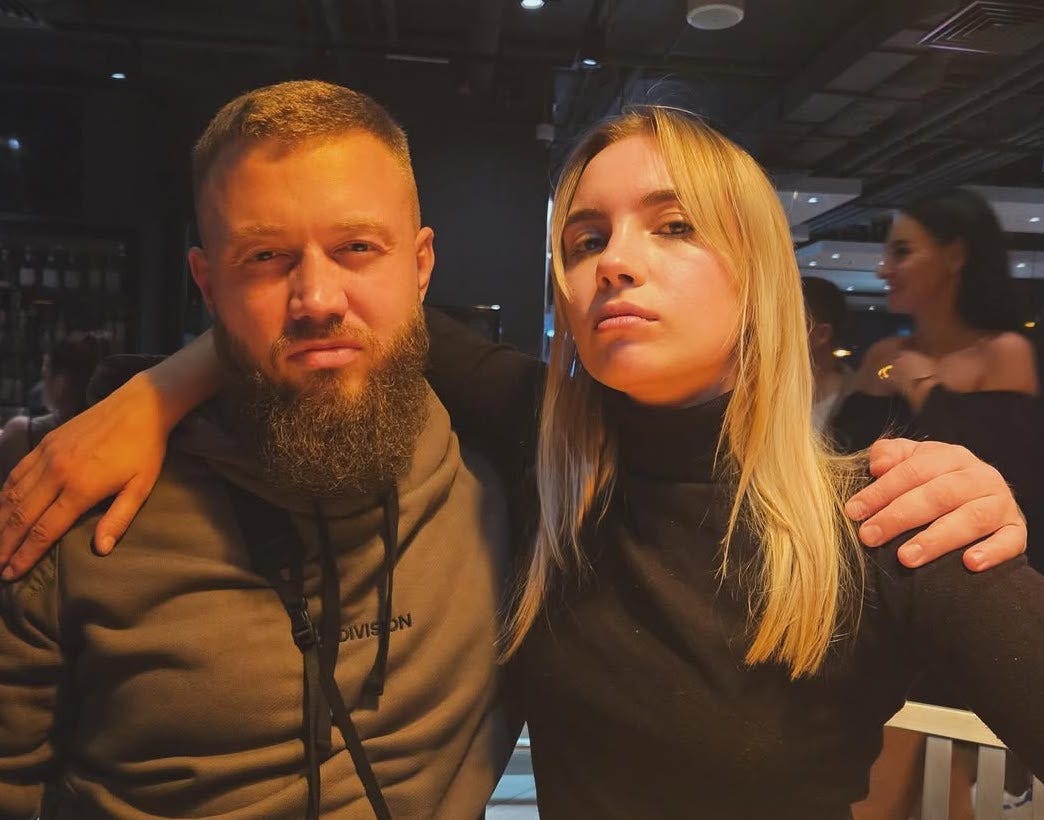
Days after Ukrainska Pravda honored Honcharuk, she made it to Harvard with SII president Sobolevsky and Giorgi Kuparashvili, the Georgian head of the Azov movement’s Yevhen Konovalets Military School (named after the founder of the fascistic Organization of Ukrainian Nationalists). They were invited to speak at the April 2025 Technology and National Security Conference hosted at Harvard Business School and MIT, which included keynote speeches from Jake Sullivan (former National Security Advisor to Biden), Mark Esper (former Secretary of Defense under Trump), and Lt. Gen. Frank Donovan, the Vice Commander of the US Special Operations Command. The Azovite panel on “Lessons Learned from Ukraine” followed Donovan’s speech, after which there was a “networking reception.”
In the coming days, the Azovite delegation visited Alabama, Washington, and perhaps other places. In the Heart of Dixie, Honcharuk, Hrytsenko, and Kuparashvili appeared at an event alongside Birmingham lawyer Stephen Humphreys, who investigated Russian war crimes in Ukraine. In Bucha, he said, “the most horrific war crimes ever imagined were committed.” Perhaps it was him who invited the Azovites to Alabama. Around this time, NPR interviewed Honcharuk and Sobolevsky, and reported that these “Ukrainian military officers are meeting with American politicians, church leaders and others to dispel what they say are the myths of Russia’s war.”
Apparently the delegation also met with think tankers in the US capital, in particular from the Atlantic Council and the American Foreign Policy Council (AFPC). Upon returning to Ukraine, Hrytsenko and Sobolevsky introduced at least one of their “American partners” to Ukrainian military intelligence chief Kyrylo Budanov, and visited the National University of Ostroh Academy. They spoke to students, telling them that “everyone will have to fight,” and signed a memorandum of cooperation with the administration.
In early May, the Senior Vice President of the neoconservative AFPC wrote an article for Newsweek, inspired by a “recent study” of the Snake Island Institute. Ilan Berman, a former CIA consultant obsessed with “taking on Tehran,” praised the “burgeoning [defense tech] ecosystem” in Ukraine, but lamented that “these innovations haven’t received enough sustained attention.” However, he added, “A cohort of activists, like those of the Snake Island Institute, a Ukrainian-based defense and security think tank, is aiming to change that—by sharing the military advancements and innovations made by their country with Western audiences.” In conclusion, Berman said that the Azovite SII has a “message worth heeding.”
Another person seemingly already wooed by the SII is Robert Potter, a “renowned cybersecurity expert” from Australia, who personally thanked the group and Vladyslav Sobolevsky in particular “for his assistance” during Potter’s latest trip to Ukraine in May. Among other things he runs the Cyber Activities Group, “a cutting-edge cybersecurity and defense application firm based in the United States and Australia.” According to the organization’s website,
[Robert Potter] is an experienced cyber, national security and government executive having held several high-profile roles as a leader in the space. These include leading the Australian Government’s cyber programs in the Pacific, being part of President Biden’s Counter Ransomware Initiative (one of 16 company executives selected globally and the only Australian), working as an expert for the United States Department of State and Global Affairs Canada as a leading expert in critical infrastructure security, sitting on the board of Ukraine’s Cyber Diia capacity building institution, leading BAE Systems Applied Intelligence cyber operations in APAC [the Asia-Pacific] and working as the first head of cyber security at the Washington Post. Robert has a history of securing and delivering large deals for partners and founding cybersecurity firm Internet 2.0.
Indeed, the SII appears to have some prominent early supporters. The president, Vladislav “Borisfen” Sobolevsky, one of the deputy commanders of the 3rd Assault Brigade and an important figure in Azov’s dormant political party, recently made a Twitter/X account. He has just 36 followers, but that includes Omri Rahmil, a former Campus Outreach Director for AIPAC in Washington who, according to his LinkedIn profile, worked for the State Department in 2021-22 in several roles, such as a “Ukraine Task Force Member.” Rahmil was also a “Presidential Management Fellow” in 2020-22. Since April 2022, he’s been an executive at Forward Global, a “global community of philanthropic funders,” which describes him in this way:
Omri Rahmil is a public affairs and policy professional in Washington, D.C. He has advised Fortune 500 executives, members of Congress, and State Department officials on a range of high-profile communications, policy, and political matters. Omri recently served at the Department of State where he advanced U.S. strategic communications priorities related to China, the Indo-Pacific, economic and business affairs, and more. He has also worked in the U.S. House of Representatives and at a boutique consulting firm.
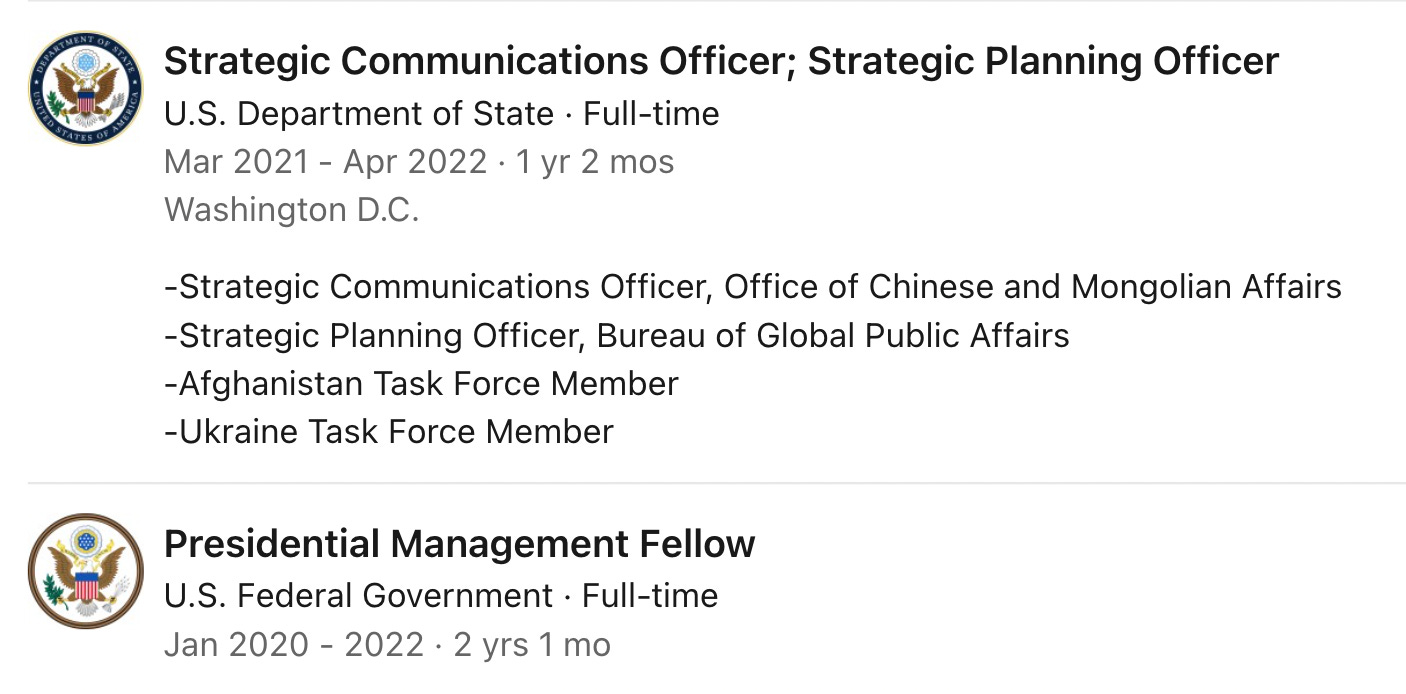
Marina Hrytsenko appears to lead a team of young Ukrainian women charged with running Snake Island Institute. Their Kyiv-based advocacy manager, Yuliia Turba, also works for the United Nations. Nataliia Zelinska, an executive assistant for SII, is an undergrad at Emory University in Atlanta, studying international relations and participating in the Model UN club. And then there is Catarina Buchatskiy, a former intern at the Ukrainian parliament and the neocon American Enterprise Institute in Washington, who is the new think tank’s Director of Analytics.

According to her LinkedIn, in 2023-24 at Stanford University’s Hoover Institution, Buchatskiy led “a joint project with [former US Ambassador to Russia] Michael McFaul on lessons from the war in Ukraine for Taiwan, including research on the use of UAVs [Unmanned Aerial Vehicles, or drones] in Ukraine and how to transfer operational and tactical lessons to Taiwan.” She was also a research assistant for Amy Zegart, a senior fellow at Stanford’s Freeman Spogli Institute for International Studies, which McFaul chairs. Some readers will recall that Stanford has hosted two Azov delegations since 2022, which were greeted by Michael McFaul and Francis Fukuyama, another senior fellow at the Freeman Spogli Institute (FSI). And of course, it was Stanford’s Mapping Militants Project, supported by the FSI and the US government, that quietly deleted its profile on the Azov movement last year.
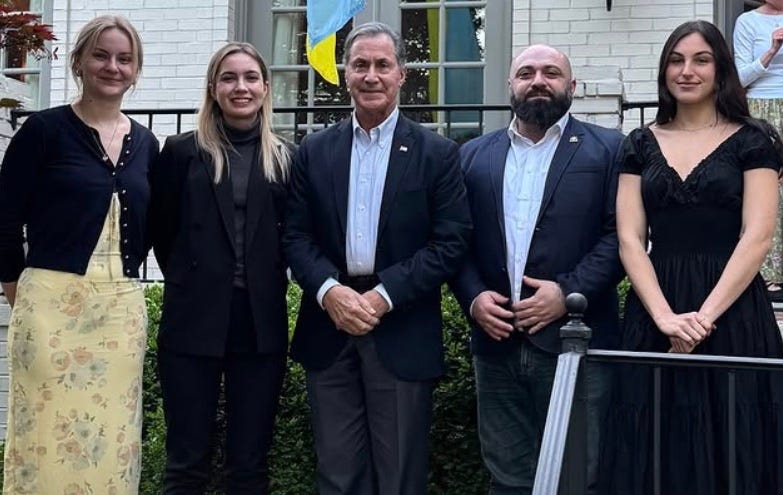
Buchatskiy’s boyfriend, Soren Monroe-Anderson, is a “former world champion drone racer” turned defense contractor. Last month, he joined the 2025 Class of Thiel Fellows. Peter Thiel, the powerful right-wing venture capitalist, has funded Monroe-Anderson’s Los Angeles-based military technology company “Neros” since at least 2024. Earlier this year, the startup drone manufacturer won contracts to supply its Archer FPV (First Person View) drones to Ukraine and the US Marine Corps. Neros reportedly “worked with the Marine Corps Warfighting Laboratory and the US Defense Innovation Unit on development of the drone over a period of 16 months.” Vice President J.D. Vance personally tested the weapon in March, about a month after humiliating Volodymyr Zelensky in the Oval Office.
PS. As it turns out, neo-Nazis may have participated in recapturing Snake Island in the Black Sea during the first year of Russia’s full-scale invasion. The Security Service of Ukraine’s Alpha Group is one of the country’s most elite special forces units. Its amphibious assault “Mich Team” lost a couple people trying to take back the strategically located island in May 2022. But this unit is associated with the rather popular Ukrainian military brand “North Side Group,” which still goes by “NS Dvizh” (‘National Socialist Movement’) on Telegram, and appears to have originated in the Azovite “Shkid” outfit of the Special Police Regiment in the Kharkiv region. At some point, I will have to return to the topic of the “Special Branding Operation to Nazify Ukraine.” As I once said on Twitter, the following mashup of videos posted by the “North Side” Telegram channels reflects Azov fighters’ idolization of US special forces AND Nazi Germany.
In Other News…
At the start of spring, Yevhen Avdeenko, a veteran of the Azov movement’s 3rd Assault Brigade who joined its ideological service, embarked on a “theatrical military stand-up” tour of the United States. He has a Black Sun prominently displayed on his right arm, which helps to cover up another (perhaps more incriminating) tattoo. As if that isn’t enough evidence that Avdeenko is a neo-Nazi, I’ve found a picture of him wearing a “Zero Tolerance” shirt, featuring an automatic weapon with a Black Sun, from a Nazi pagan brand. I also discovered that he “liked” an Instagram video of an Azovite Nazi pagan ceremony from 2017, with music added from the National Socialist Black Metal group “M8L8TH” (also known as “Hitler’s Hammer”). The video includes Nazi salutes “to the sun,” which are alluded to in the caption of the Instagram post with palm and sun emojis.
Meanwhile, the Ukrainian documentary “People of Steel,” about the 2022 siege of Mariupol, toured the United States. The film apparently glorifies Azov, and features prominent “Azov Lobbyists” such as “Gandalf,” who made the fanciful claim (as seen in the trailer) that “up to 100,000 people” died in Mariupol. During the battle, he put the number at 25,000 civilians, which is still far higher than the estimate from Human Rights Watch and others (“at least 8,000 people,” including soldiers).
Earlier this year I wrote about “2000 Meters to Andriivka,” a sequel to the Oscar-nominated documentary “20 Days in Mariupol,” which went with Azov’s number of 25,000. Whereas Azov was mostly absent from “20 Days,” an openly neo-Nazi unit in the 3rd Assault Brigade stars in “2000 Meters.” The latter, which appears to be a pro-Nazi propaganda film, made its world premiere at the Sundance Film Festival in January. Since then, it has been screened in Copenhagen (March) and the Cannes Film Festival (May). About a week ago, “2000 Meters” made its debut in Ukraine, and several Azov fighters were invited to the event. At least one of them, Andriy “2.0” Serhiyenko, is a “legionnaire” of the neo-Nazi paramilitary group “Centuria.”
When Vladyslav Sobolevsky, the president of Snake Island Institute, made his first visit to the United States this year in February, his delegation met with Oleksandr Tkachenko, a Detroit-based fundraiser for the Azov units. In April, Tkachenko met Viktoria Honcharuk and Giorgi Kuparashvili, who gifted the major Azov supporter three copies of a painting, depicting the daring evacuation of severely wounded Azov fighters from Mariupol, that hangs in the office of military intelligence chief Kyrylo Budanov. Last month one of the replicas joined a special exhibit of “trench art” and war memorabilia (much of it Azov-related) that Tkachenko has curated at the Ukrainian American Archives and Museum of Detroit. (Below is Tkachenko’s walk-through of the exhibit.)
It was in mid-April that US Congressman Brian Fitzpatrick (R-PA), a former FBI Special Agent, visited “some Ukrainian warriors” from the 3rd Assault Brigade, allegedly near the front line, after meeting with Zelensky in Kyiv. “This is just one example of Russian occupied territory, up until not too long ago, that they’ve completely burned down,” said Fitzpatrick. “This is what the Russians do. They just level buildings, indiscriminate burning and destruction of civilian areas and that’s their M.O., that’s what they do.” Of course, the Congressman recently reaffirmed that “we stand—as we always have—with our ally Israel in shared purpose and mutual defense.” Back in February, Republican leaders in Congress tapped Fitzpatrick to chair the House Permanent Select Committee on Intelligence’s Central Intelligence Agency Subcommittee, “an elite and highly sought-after leadership post charged with overseeing all operations of the Central Intelligence Agency (CIA), including all international covert operations.”
As the CIA Subcommittee chairman rendezvoused with Ukraine’s most powerful neo-Nazis, Azov officer Dmytro “Diplomat” Andryushchenko visited the Royal Military Academy Sandhurst in England, more or less the British army’s West Point. “Diplomat” also met with the former general turned ambassador Valery Zaluzhny, and joined a “Free Azov” protest in London. In both cases he displayed a Ukrainian flag emblazoned with the chevron of the Azov Brigade and a soldier who appears to be wearing an “Operator Skull” (updated Nazi Totenkopf) patch from the neo-Nazi brand “R3ICH.” Although he made the trip with the “Carpathian Bears,” a football “charity team for veterans” founded in 2023, Andryushchenko also represents the National Guard’s Azov Brigade in the Coordination Headquarters for the Treatment of Prisoners of War, which is led by Ukrainian spymaster Kyrylo Budanov and his spokesman Andriy Yusov. The Coordination Headquarters appears to have played an important role in organizing foreign lobbying trips for former Azov POWs, such as Valery Horishny, the one who wrote poetry for Hitler, but still managed to speak at the United Nations and British parliament this past winter.

More recently, Horishny spoke at the Kyiv Security Forum and the German parliament. His trip to Berlin last month with other representatives of the Azov Brigade was organized by Sergej Sumlenny, a notorious German think tanker from Russia and “former employee of Putin’s spin doctor” who became “the star of English-speaking and Ukrainian-language Twitter,” and affiliated with the German Green Party. The Azovites had a busy trip to Berlin, which the 1st Azov Corps in the National Guard of Ukraine proudly summarized to its social media followers.
On the eve of the anniversary of the exit of the Mariupol Garrison into Russian captivity, the delegation of the 1st Corps of NGU "Azov" held a series of high-level advocacy measures in Berlin. On May 13, in the Bundestag, the delegation took part in a parliamentary event on the issue of protecting the rights of prisoners of war and supported by the office of MP Robin Wagener [The Greens] in collaboration with the European Resilience Initiative Center. The event was attended by representatives of democratic parties. Among other: Defense Committee member Roderich Kizevetter (HDS) and European Policy Committee member Johannes Sharps (SDPN), Chairman of the European Affairs Committee Anton Hofreiter, Security Policy Speaker Sarah Nanni, Defense Committee member Agneszka Brugger and others. There were also experts in international law, human rights activists, journalists and representatives of the International Committee of the Red Cross.
Senior Sergeant Valery Horishny, who spent two years and four months in Russian captivity, gave testimony about the conditions of detention, systematic torture, moral destruction, as well as the path of rehabilitation and return on track. Junior Sergeant Nestor Barchuk stated that tortures and violence in Russian captivity are not single cases, but a targeted state policy of Russia aimed at destroying Ukrainian identity. According to him, more than 90% of Ukrainian prisoners of war go through systematic torture and humiliation, so Russia should not escape responsibility.
The delegation held a separate meeting on May 12 at the Foreign Ministry with Conrad Artz von Straussenburg and Eva Lannert, responsible for policy concerning Eastern Europe and Ukraine. With the assistance of the German-Ukrainian Bureau, the delegation held bilateral meetings with the deputies of the Bundestag and became part of the dialogue in the Foreign Policy Analysis Center European Council on Foreign Relations. Representatives of the delegation also reported at the Conference on Security Architecture of Europe and on the panel of the UN International Intergovernmental Conference organized by the Konrad Adenauer Foundation.
Azov mentioned “the assistance of the German-Ukrainian Bureau,” which describes itself as “an expert company focused on research and strategic advisory to enhance German-Ukrainian relations.” Its CEO Mattia Nelles greeted what he called “a group from the legendary Azov Brigade in Berlin.” He publicly thanked Sumlenny, on the day that Azovites spoke in the Bundestag, for “enabling these incredible voices to being heard by more people.” In return, Sumlenny thanked Nelles “for having organized an additional greet meeting today.”
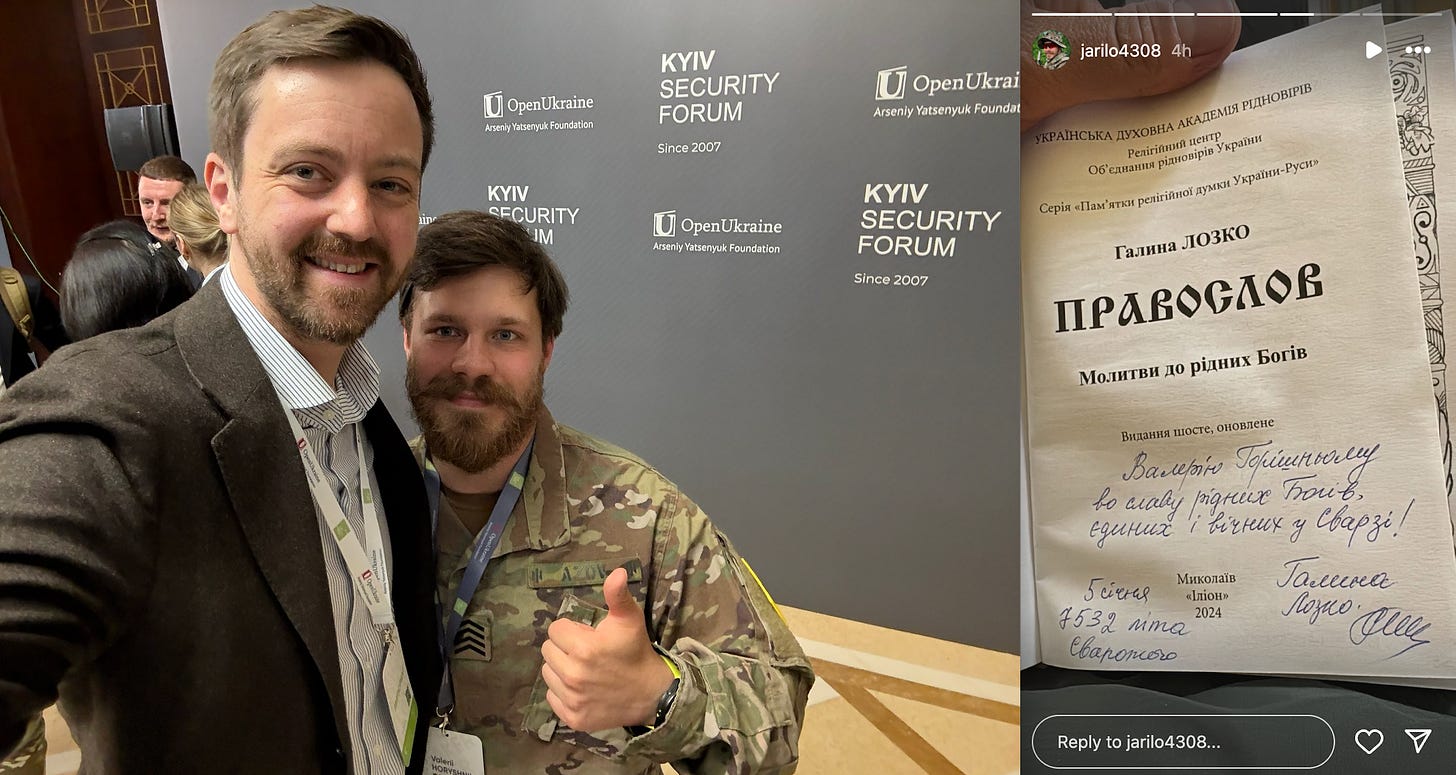
The German-Ukrainian Bureau CEO said that Valery “Yarylo” Horishny’s testimony was the most powerful. As he explained, they were already introduced to each other at the latest Kyiv Security Forum: “Before meeting the group in Berlin, I recently met Yarylo in Kyiv and was astonished by his strength, composure and ability to speak about what he had to endure for nearly three years. … See you [again] in Kyiv, mate.” The journalist Leonid Ragozin recently noted that Horishny “tells somewhat contradictory stories of his imprisonment.”
“My fellow prisoners of war and I endured systematic torture in detention. It included inhumane treatment, brutal beatings, some leading to lethal cases, including with electric shock and other forms of torture”, he said at the hearings in the UN in January. But here is what he told the Ukrainian outlet Media Port: “Speaking about conditions [in Russian captivity] - I’ll say that it all depends on the location, it can be normal sometimes. There were kind people who helped us. There were mental people who allowed themselves too much. There are people who are not returning in such a good and cheerful state as I do. There are people who they tried to break and who got broken. Different methods of influence were applied to different people, so to say. Maybe I was lucky, but my conditions in captivity were not too bad, because there are people who went through hell”.
Viktoria Kovach, who leads the medical service of the 3rd Assault Brigade, also made a trip to Germany last month, after joining a session of the NATO Military Medicine Centre of Excellence in Poland. She appears to have met with an official from the German Army Medical Service in Berlin. Kovach also visited Leipzig, where the European Gymnastics Championships was taking place, and the Ukrainian men’s team paid tribute to the Azov-affiliated Kraken Regiment, an elite neo-Nazi unit at the disposal of Ukrainian military intelligence. Meanwhile, a neo-Nazi former press officer of the National Guard’s Azov Regiment, Dmytro Kozatsky, took a trip to Amsterdam, around the time that a “Free Azov” mural appeared in the city. More recently, the neo-Nazi commander of the 3rd Assault Brigade’s anti-tank battalion, Oleh Romanov, visited his family in Washington, DC. The German left-wing newspaper junge Welt already reported on Horishny’s trip to Berlin, but everything else you’ve read in this seasonal edition of the Azov Lobby Blog has escaped the attention of journalists around the world. What will summer bring?
P.S. For now everything is free on the Azov Lobby Blog. If you want to support my work, you can “Buy Me a Coffee,” or pledge to become a paid subscriber, so I can dedicate more time to this newsletter.









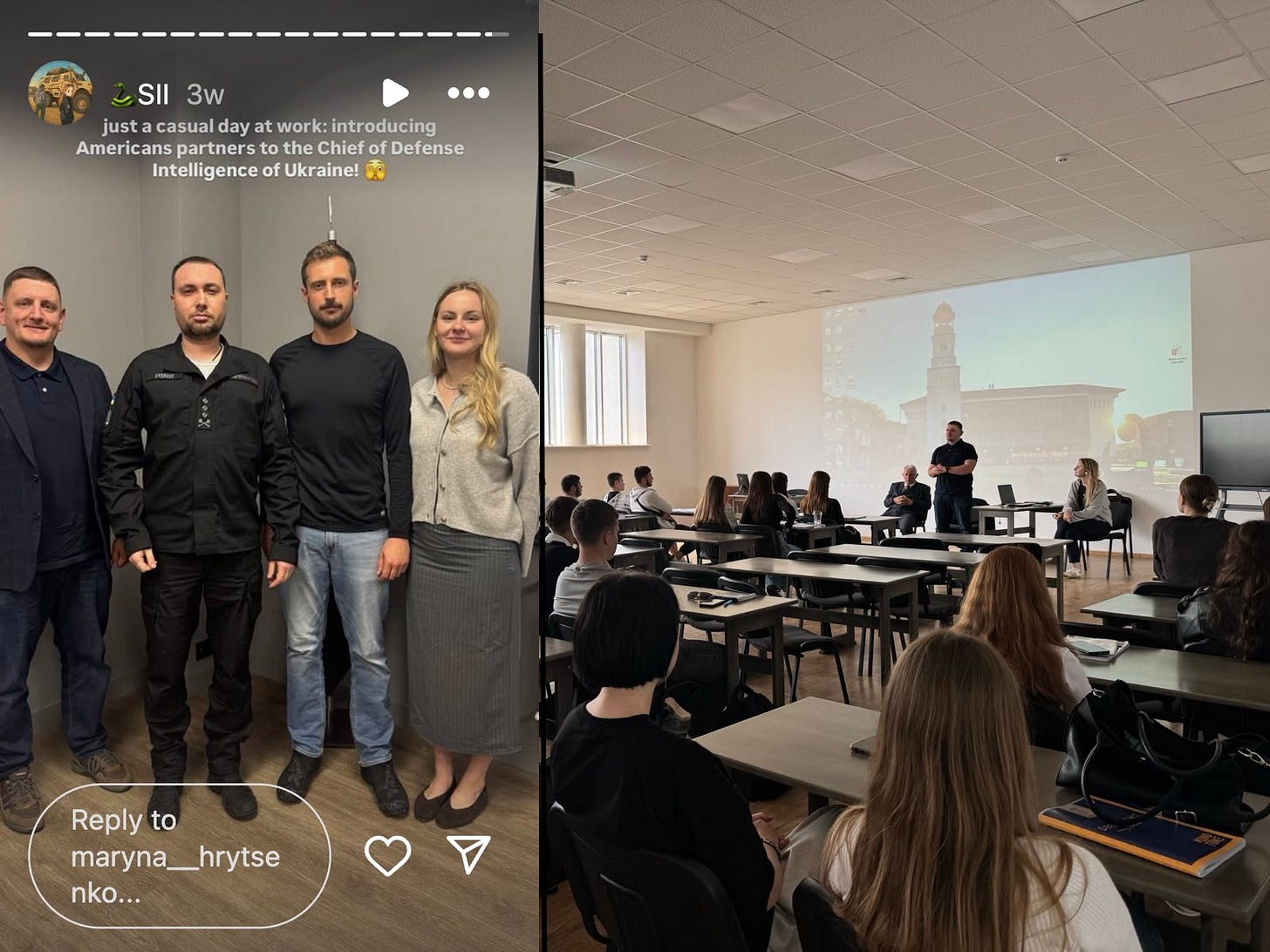



I'm on fixed income, which translated from neo-liberal speak means insufficient income so I can't afford to join a regular payment subscription. However I've got a surprise bit of cash coming, I'd like to send you as I do with others something via buy me a coffee or other service. Maybe you can put that in your "about" section?
Love reading your blog. So proud of the accomplishments that Ukraine's ns movement has made. Hope to see more whining from you!